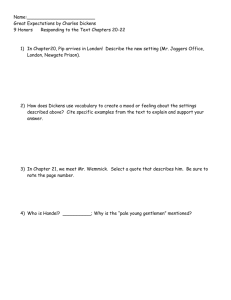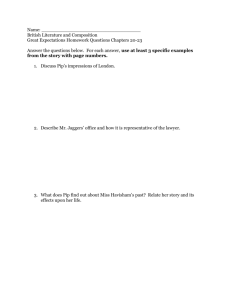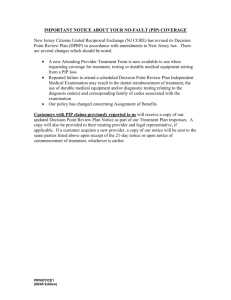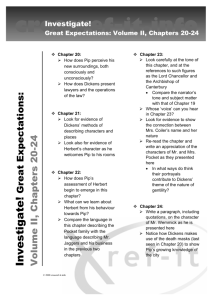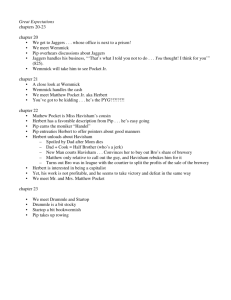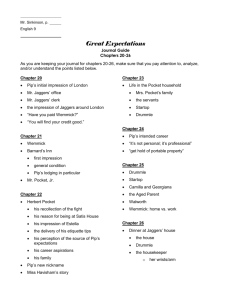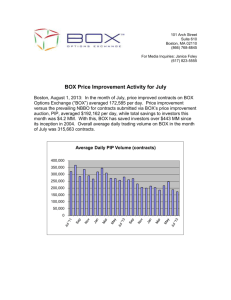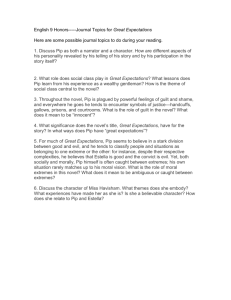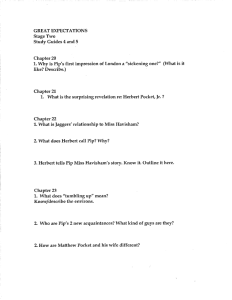Part 2 Great Expectations Reading Questions
advertisement
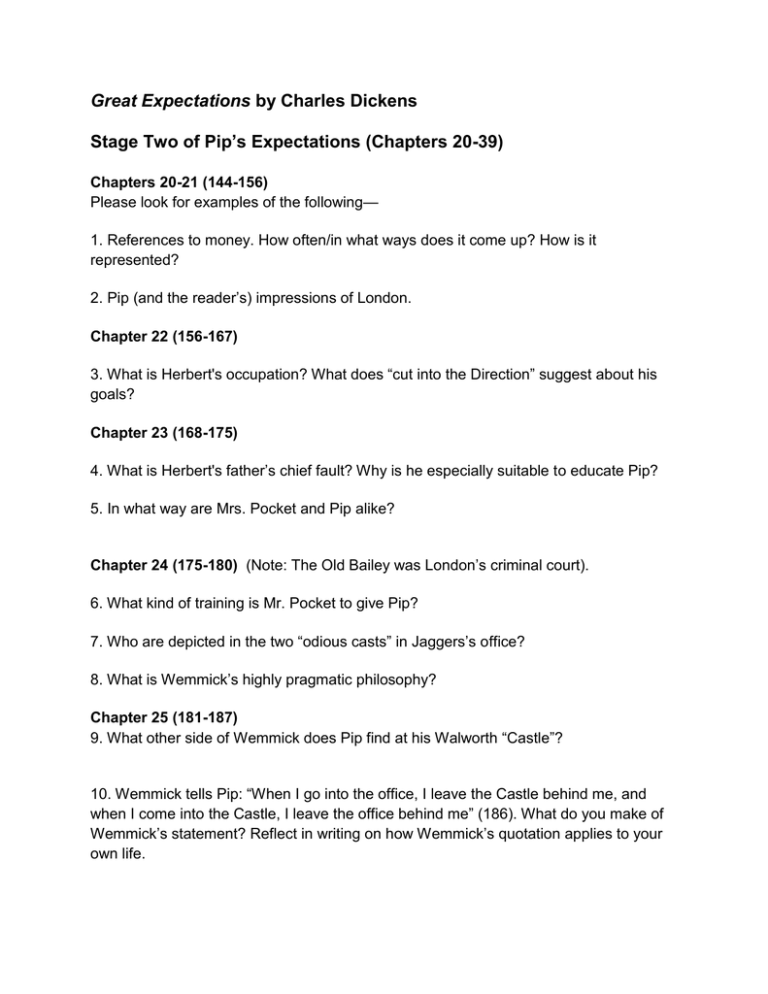
Great Expectations by Charles Dickens Stage Two of Pip’s Expectations (Chapters 20-39) Chapters 20-21 (144-156) Please look for examples of the following— 1. References to money. How often/in what ways does it come up? How is it represented? 2. Pip (and the reader’s) impressions of London. Chapter 22 (156-167) 3. What is Herbert's occupation? What does “cut into the Direction” suggest about his goals? Chapter 23 (168-175) 4. What is Herbert's father’s chief fault? Why is he especially suitable to educate Pip? 5. In what way are Mrs. Pocket and Pip alike? Chapter 24 (175-180) (Note: The Old Bailey was London’s criminal court). 6. What kind of training is Mr. Pocket to give Pip? 7. Who are depicted in the two “odious casts” in Jaggers’s office? 8. What is Wemmick’s highly pragmatic philosophy? Chapter 25 (181-187) 9. What other side of Wemmick does Pip find at his Walworth “Castle”? 10. Wemmick tells Pip: “When I go into the office, I leave the Castle behind me, and when I come into the Castle, I leave the office behind me” (186). What do you make of Wemmick’s statement? Reflect in writing on how Wemmick’s quotation applies to your own life. Chapter 26 (187-194) 11. What are some of the words or images you associate with Mr. Jaggers’s house at Gerrard Street in Soho? 12. What is mysterious about Molly? Chapter 27 (194-201) 13. Who is the avenging phantom? What does he signify about Pip’s life in London at this point in the novel? 14. Close read Joe’s speech to Pip that begins “Pip, dear chap, life is made of ever so many partings welded together …” (200-201) Chapter 28 (201-206) 15. How is the convict theme re-introduced? 16. Who is famous in his hometown as Pip’s earliest companion, patron and friend? What is Pip's attitude to this supposed fact? Chapter 29 (207-218) 20. Close read the long paragraph on P201 in which Pip is “painting brilliant pictures of [Miss Havisham’s] plans for [him]”. Pay particular attention to Pip’s imagery. What role does Pip see himself as he returned to Miss Havisham’s? 21. In his feelings for Estella, how does Pip come to follow Miss Havisham’s teaching? 22. Why does Pip not visit Joe? Chapter 30 (218-226) and Chapter 31 (226-231) 23. Why does Herbert tell Pip he is going to be “disagreeable?” 24. What’s the situation with Herbert’s engagement? What do you think its relevancy is to the novel at this point? Quick summary of Chapter 31: Pip and Herbert attend a dreadful performance of Hamlet, in which Mr. Wopsle plays the lead character. What audience is there rowdily boos and mocks the performance after which point, Pip and Herbert are asked back to Wopsle’s dressing room, where they lie about the performance’s success (it went off “capitally” Pip suggests). They then invite poor Mr. Wopsle out to dinner. The chapter itself is a kind of humorous distraction—particularly if you know the plot of Hamlet—and it highlights another instance in which someone from Pip’s early life appears out-ofplace in London. Pay attention to the final paragraph of the chapter (on P231), which ends the installment as well. Chapters 32-33 (231-243) 25. In Chapters 32 and 33, two seemingly unrelated themes touch here: criminality and violence, on the one hand, as represented by Newgate Prison, and, on the other hand, the cultivated, lovely and remote Estella. Read closely the places where these two themes come together, especially the last two paragraphs (one long, one a singlesentence) on P236 and Estella’s curiosity about and reaction to Newgate, on the bottom of P240. How does Pip register the relation between these two parts of his life? 26. What’s the relationship between the main thrust of Chapter 34—where Pip and Herbert “look into their affairs”—and the last paragraph of the chapter? How are the two juxtaposed? Read for tone as well as content. Chapters 35-37 (243-268) 27. Pay particular attention to the latter half of Pip’s conversation with Biddy (253-254). What do you notice? Chapter 36 (255-261) 28. How do Pip's fortunes improve on his twenty-first birthday? What does Pip still not find out? Chapter 37 (262-268) 29. What plan does Wemmick propose for Pip's desire to help Herbert? What humorous touch concerning Wemmick is shown? Chapters 38-39 (268-291) 30. Read Chapter 38—the “one chapter to Estella”—and in your notes choose a sentence or short passage and close read it with an eye to both its content and its form—diction, syntax (word order), imagery, metaphors, repetition, connections to earlier scenes, etc. Copy the passage in your notes and annotate it. 31. Compare the encounters between Estella and Miss Havisham in Chapter 38 (specifically, pages 270-75) and Pip and the guest in Chapter 39. What similarities/differences do you notice?
